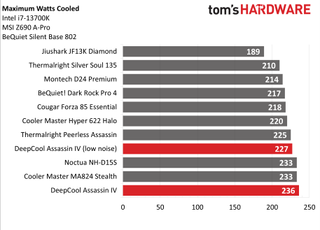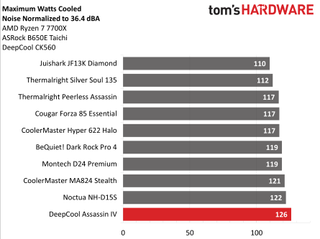Why you can trust Tom's Hardware
Intel Core i7-13700K thermal results with noise normalized to 38.2 dBA
Finding the right balance between fan noise levels and cooling performance is important. While running fans at full speed can improve cooling capacity to some extent, the benefits are limited and many users prefer a quiet system.
In this test where the fans have been set to low noise levels, DeepCool’s Assassin IV ties for Cooler Master’s new Stealth for the best result we’ve seen on any air cooler – cooling 222W when paired with Intel’s i7-13700K!

No Power Limits Thermal Results
Without power limits enforced on Intel’s i7-13700K, the CPU will hit its peak temperature and thermally throttle with even the strongest of air coolers. In this test, we measure the total amount of watts the cooler is able to dissipate from the CPU.

Here we have another chart-topping result, with DeepCool narrowly edging past both Noctua’s NH-D15S and Cooler Master’s MA824 Stealth with 236W cooled during the course of testing. Switching to the low noise mode reduces total cooling capacity slightly, with an average of 227W cooled. This outperforms both the Peerless Assassin and Montech’s D24 Premium.
The maximum noise levels of the Assassin IV are also very good. It’s slightly quieter than Noctua’s NH-D15S and barely louder than Cooler Master’s MA824 stealth. At 42.9 dBA, the noise levels are audible, but far from loud.

175W Cinebench Results

Most coolers on the market are able to keep Intel’s i7-13700K under its peak temperature if the power consumption is limited, so for this test we’ll be looking at the CPU’s actual temperature.
With this slightly restricted workload, DeepCool’s Assassin IV performs very well – but runs a little hotter than Noctua’s NH-D15S. There’s not much of a difference between the full-speed and low-noise modes. But the low-noise mode runs significantly quieter. In the full-speed profile, the cooler hit its maximum noise level of 42.9 dBA in this test. Switching to the low noise mode only increases the CPU’s temperature by a single degree, but reduces the noise profile considerably – at only 38.2 dBA, it runs very quietly and is barely audible.

125W Cinebench Results
The lowest power limit I test with Raptor Lake CPUs is 125W. This is a high enough limit to allow the CPU to maintain its base clock speeds even in the most intensive tests. And even low-end coolers should be able to keep the CPU below Tjmax, the highest temperature the chips is designed to run at before throttling.

The Assassin IV again delivers chart-topping thermal performance here, and it does so while running fully silently. With this system using BeQuiet’s Silent Base 802 PC case, the minimum noise levels reach 37.3 dBA. That’s also the acoustic measurement when testing at this lower power limit, both in full speed and low noise modes, which means that the cooler was running quieter than the sound of my system’s fans. This is an excellent result for noise levels.

AMD Ryzen 7 7700X Thermal Results
It’s great to see how coolers perform with hotter CPUs like Intel’s i7-13700K, but that performance doesn’t always directly translate to how other CPUs will operate with the same coolers. Some coolers might perform better – or worse – depending on the CPU it’s paired with. So I’ve included AMD’s Ryzen 7 7700X results to show how the cooler reacts when installed in a current-gen AMD system.
Thermal Results with noise normalized to 36.4 dBA

With noise levels set to 36.4dba, I measured 126W cooled on average during the course of testing. This is the best result I’ve seen from an air cooler and is only a few watts short of the cooler’s performance when noise levels are not restricted.
Maximum Cooling Capacity with maximum fan speeds

Next, we test the cooler’s maximum cooling capacity by allowing the fans to run at full speed. In this test, DeepCool’s Assassin IV cooled 130W on average, placing it among the best results we’ve seen on an air cooler. This is only a few watts short of AMD’s default power limit for Ryzen 7700X, which allows the CPU to use up to roughly 140W.
With maximum noise levels of 42.9 dBA, the Assassin IV runs slightly louder than Cooler Master’s MA824 Stealth and slightly quieter than Noctua’s NH-D15S.

Thermals and Acoustics with a 95W Power Limit

Not every task will force the CPU to use its full potential or maximum power draw, so it’s good to test coolers in a variety of power limits. In these situations, it’s generally more important to consider the noise levels, and the Assassin IV does great in that respect with noise levels of only 39.1 dBA. It maintains this low noise level while keeping the CPU cooler than any of the other coolers we tested for this review, maintaining a lead of 4C over its nearest competitor. This is an excellent result, showing the strength of DeepCool’s design.

Thermals and Acoustics with a 75W Power Limit
With power draw reduced to 75W on AMD’s Ryzen 7 7700X, this thermal load shouldn’t be difficult for most coolers to cool. This is roughly the amount of power Ryzen 7 7700X CPU will use during gaming, and it’s also the maximum power consumption of AMD’s non-X Ryzen 7 CPU.

At 36.4 dBA, the noise levels for the Assassin IV are extremely quiet, almost silent, matching Noctua’s NH-D15S.
At this lower level of power consumption, cooling difficulty isn’t hard at all and even the most basic coolers should have no problems here. In this situation, the temperature of the CPU isn’t very important – even the most basic coolers should be capable of handling the heat of a 75W power limit.

Conclusion
DeepCool’s Assassin IV offers a compelling package with chart-topping cooling performance, balanced noise levels and full RAM compatibility – what more could you want in an air cooler? The unique form factor is reminiscent of a Borg Cube, and the Assassin IV assimilates (and dissipates) the heat of demanding workloads with ease.
This air cooler offers top-tier cooling performance balanced with low noise levels – and the quiet mode switch will be appreciated by those who demand silent operation. Air coolers of this class don’t come cheap, though. At $99, this Assassin is firmly in the premium price range – but that’s backed up by the impressive, quiet performance we’ve shown in our testing above.

Albert Thomas is a contributor for Tom’s Hardware, primarily covering CPU cooling reviews.

AMD Ryzen 7 9800X3D beats the 7800X3D by 26% in leaked Blender benchmarks — outpaces even the current-generation Ryzen 7 9700X by 11%

Google creating an AI agent to use your PC on your behalf, says report

Electronics boffin creates slot-in MacBook SSD module system — breaks storage limits for every modern MacBook
-
Albert.Thomas Replymwm2010 said:I wonder if they'll make an RGB version of this.
I believe a "digital" version is planned, which has a light RGB flair and an LCD screen for displaying stats (temp, utilization, etc.) -
Co BIY "You will be Assimilated" - I do appreciate a good "Borg" reference.Reply
I tended to dislike the Borg storylines but now that I see all the Borgs in real life I know that their "boringness" is part of the terror. -
Albert.Thomas Reply
The Assassin IV Digital probably won't be available for a few more months. However, the other Digital Coolers launch later this month. I have the AK620 Digital on my i7-13700K test bench right now, so we'll have a review on Tom's Hardware covering the features of the Digital series soon (probably by the end of the month)mwm2010 said:I might actually buy that digital version -
Lucky_SLS Could you maybe include the big boy from thermalright in the comparison charts? - Thermalright Frost Commander 140Reply
-
-Fran- Reply
It is, for sure, one of the best. I don't like the overly "Borg-ey" appearance, but it's not bad looking per se. That extra fan config though... That looks ugly XDAlbert.Thomas said:This is, without a doubt, my new favorite air cooler
Now, allow me to say this test only shows the NH-D15 is just a beast. It was when it launched a lot of years ago and it is still a beast. This only makes me want Noctua to release its successor already!
And thanks for the testing, Albert! Quite a lot of good information in your charts, specially the "max watts cooled" one. I believe you've found a very good way of reporting a universal (somewhat) dissipation potential for all coolers. Paste and case come into play as well, but you can account for those as asterisks, just like any other measurement (and you do, mind you). I wish you could consolidate more coolers into that chart, but using a 13900KS with no restrictions.
Regards. -
Albert.Thomas ReplyLucky_SLS said:Could you maybe include the big boy from thermalright in the comparison charts? - Thermalright Frost Commander 140
I've asked for a sample of this before, I'll ask again.
